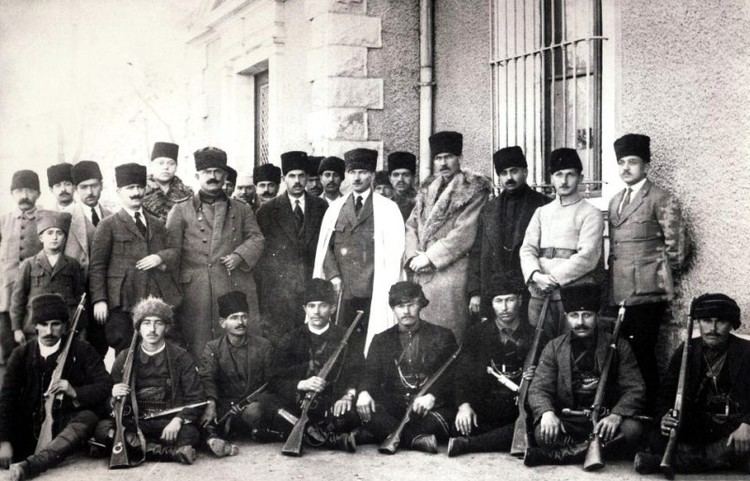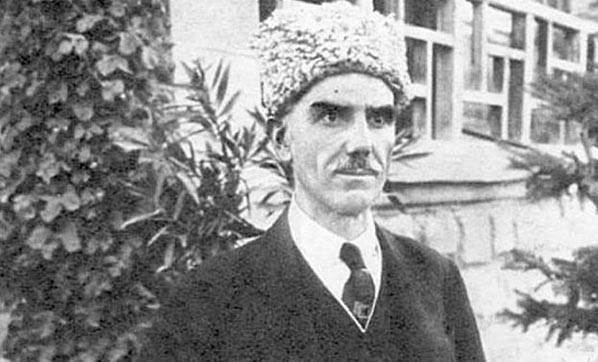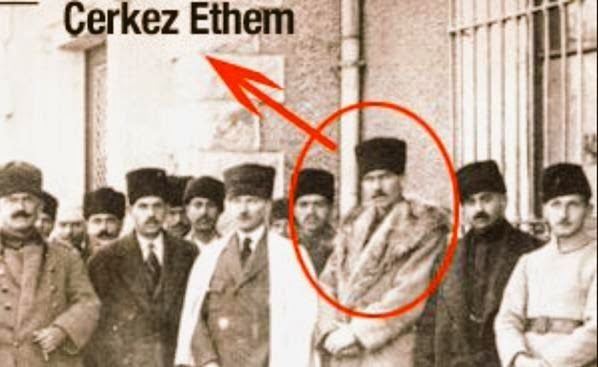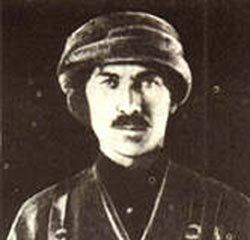Ethnicity Circassian Parents Psevu Ali Bey Role Military officer | Name Cerkes Ethem Religion Sunni Muslim | |
 | ||
Education Bakirkoy Cavalry Junior Officer School Siblings Cerkes Resit, Nuri Bey, Ilyas Bey, Tevfik Bey Similar People | ||
erkes ethem belgeseli
Çerkes Ethem (Turkish for "Ethem the Circassian"; 1886 – 21 September 1948) was a Turkish militia leader of Circassian origin who initially gained fame for fighting against the Allied powers invading Anatolia in the aftermath of World War I and afterwards during the Turkish War of Independence.
Contents
- erkes ethem belgeseli
- Fuat Uur Vatanm Sensinde erkes Ethem Skandaldr
- Early life and family
- Education and military career
- Cooperation with Atatrk
- Death and burial
- Exhumation and reburial plans
- References

Fuat Uğur: Vatanım Sensin'de Çerkes Ethem Skandaldır
Early life and family

His family, of the Circassian (Adyghe) people, was originally from Circassia who migrated to Turkey in the 1860s. He was born in Emre village of Bandırma as the son of Pshevu Ali Bey. One of his brothers was a Member of Parliament for Saruhan (present-day Manisa) in the Grand National Assembly of Turkey's first legislative term and previously in the fourth term of the Chamber of Deputies of the Ottoman Empire. His other brother was a senior military officer who graduated from the Turkish Military Academy in 1902.

Ethem the Circassian had blond hair, light blue eyes, and very pale skin, as described by Halide Edip Adıvar. He stood at 2.00 m (6 ft 7 in) tall.
Education and military career
He ran from home when he was 14 years old to join Bakırköy Cavalry Junior Officer School. He joined the Balkan War and was wounded on the Bulgarian front. As a result he was awarded with honours and seniority allowance. Later he joined Teşkilat-ı Mahsusa organized by Eşref Kuşçubaşı and participated in operations in Afghanistan and Iraq during World War I. He was again wounded and retired to his village. For a while he took up banditry in the mountains. He then founded Kuvâ-yi Seyyâre which was the only organized military force in Anatolia during 1919–1920, period between the Armistice of Mudros and the Treaty of Sèvres. He coordinated his military operations with Ali Fuat Paşa in Ankara and harassed the invading Greek armies with his fast cavalry. He was instrumental in putting down various rebellions against the authority of the Grand National Assembly of Turkey. Eventually he had a disagreement with the İsmet İnönü government in Ankara, refusing to join his forces with the regular army established under the command of İnönü Paşa. Newly-reconstituted Turkish Army had to put down the situation whilst also fighting the Greeks at First Battle of İnönü. His alleged subsequent surrender to and cooperation (disputed by historians in Turkey until his restoration of honour) with the Greek army resulted in his citizenship getting revoked on the grounds of treason and his being announced a persona non grata by the TBMM, amongst many others. From Greece, he went to Jordan and settled there.
Cooperation with Atatürk
Çerkes Ethem was an ally of Mustafa Kemal Atatürk who appreciated him for his successful fight against invading armies and bandits in different regions of Turkey. Atatürk awarded Ethem the Circassian with the title of Millî Kahraman (Turkish: National Hero).
In her 1928 work The Turkish Ordeal, the leading Ottoman female novelist and nationalist Halide Edip Adıvar mentions the first time she saw Ethem the Circassian and how well he was treated by Mustafa Kemal Atatürk in addition to describing Ethem Bey's physical appearance as the following:
When he [Ethem the Circassian] came the streets were thronged with his men, all of them beautifully equipped in a wild irregular fashion. The sight was rather imposing. There were even women fighters. Edhem himself was the picturesque of all. He was received with great honors. Mustafa Kemal Pasha lent him his car, the only car we had in Angora then; and the National Assembly stood up and greeted him with loud cheers. It was at headquarters that I saw him first. One morning on the way to my office I found myself among a crowd of armed men who stood starring at the central hall with their hands on their hips. I knew them at once to be Nationalist fighters and guessed they were Edhem's body-guard. Later I went into the central hall to show some reports to Mustafa Kemal Pasha and found there a tall gaunt figure sitting in an arm-chair opposite Mustafa Kemal Pasha. As he rose to kiss my hand I saw how tall and unusually striking he was. He had to stoop to speak to us and his figure was more like that of a power skeleton than like that of a body of flesh and blood. It was built on the best Circassian model – very high shoulders, a slim waist, long arms and legs, and a large fair head with a short nose and eyes whose gaze was even paler and colder than that of Mustafa Kemal Pasha. The whole face was very pale, the sort of pallor that is unaffected by the sun, wind or frost. And sometimes the eyes paled to a degree of colorlessness that was uncanny. The short nose gave the cadaverous features pugnacity, and the cheek-bones, chin, and well-shaped head an air of pride. I could not help thinking that it was not the famous soldiers or the intelligentsia in Angora who put Mustafa Kemal Pasha in the shade, but this fantastic-looking simple Circassian.
Death and burial
Ethem Bey died on 21 September 1948 near River Jordan in Amman, Jordan. He was buried in the Kabardian Cemetery
Exhumation and reburial plans
In 2015, the Deputy Prime Minister of Turkey announced they are planning the exhumation and reburial of Ethem Bey in Turkey where he was born.
